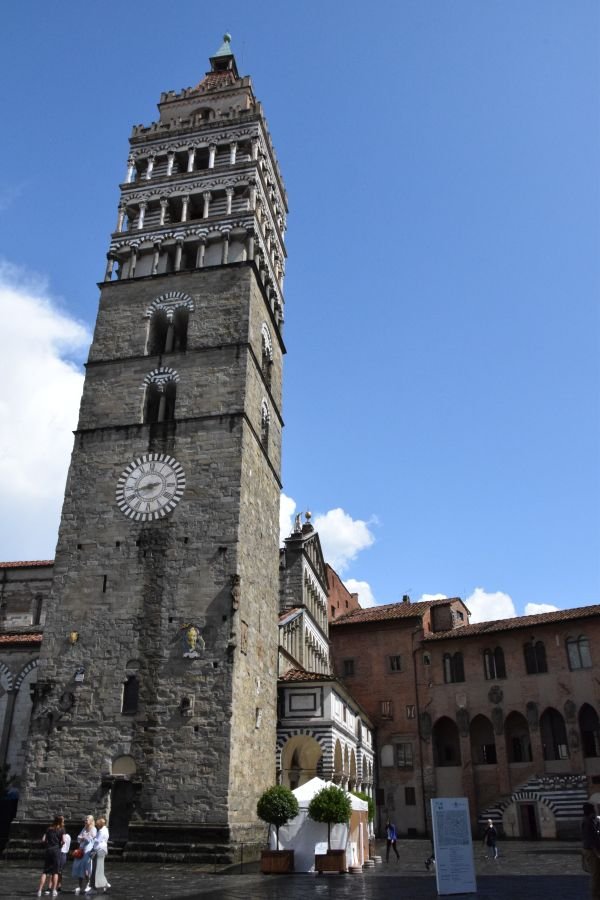
Discovering Pistoia, the Italian Capital of Culture for 2017
This year Pistoia is the Italian Capital of Culture. The nomination seems to be a recognition to the harmony, composure and human dimensions of an urban, social, historical and artistic agglomeration that has managed to find its identity despite the proximity and importance of Florence, Lucca and Pisa. Less famous than the other beautiful cities of Tuscany, it is certainly not less beautiful and interesting, especially for its ability to coexist past and present, learned culture and popular culture.
The main square, Piazza del Duomo, next to the Palazzo dei Vescovi and Palazzo del Comune, houses the Cathedral of San Zeno, a beautiful Romanesque church with a portico of white and green marble. To the side is the bell tower, from whose summit you can enjoy a beautiful view. On the other side of the piazza il Battistero, built in' 300 and dedicated to San Giovanni. We move a little further on and we find Piazza della Sala, the space of the city market, in the morning full of stalls full of fruit, vegetables and food. On the perimeter of the square cafes, taverns, restaurants, shops ready to welcome, especially from late afternoon onwards, the Pistoiesians and tourists, who are however a little special, because they have found time to deviate from the larger flows and the almost obligatory stops of a tour in Tuscany and have had the common sense or luck to discover a so-called minor center that deserves to be known and appreciated.
And here we are at the Ospedale del Ceppo, a short distance from the Duomo: it is no longer a health facility for years and should become a cultural centre and an exhibition venue. Remarkable is the frieze of bas-reliefs in brilliant colours of glazed terracotta from the time and the school of Luca della Robbia that adorns the whole facade of the building. Inside there is another little gem: the Anatomic Theatre, in neoclassical style, which was used to illustrate the lessons of the School of Anatomy. You visit it by taking the path of Pistoia Sotterranea, in practice it resurfaces in this room from a walkway below the city.
Finally, among the things not to be missed in a short tour of the Tuscan capital, here is the new and large civic library that stands outside the old town centre, but still very close to the railway station, in the area where Breda was developed, a bus and train factory. This company has been an important part of the city's history; its warehouses, once the production has moved out of town, have been recovered to offer citizens and visitors a series of spaces that can be used in various ways. The Library is on three floors: the ground floor with the gallery includes the cafeteria, multimedia stations, a colorful and cheerful children's space, the newspaper library. At the entrance, a sort of permanent exhibition tells the story of Breda and Pistoia in various posters.
Festivals
Two important festivals are held in Pistoia each year. At the end of May "Dialoghi sull' Uomo" brings together prestigious Italian and international guests in very interesting conference forums, open to the public and always crowded.
The "Pistoia Blues" is the traditional appointment in Piazza Duomo with the most interesting names of the international music scene: the whole city in July is filled with sounds and visitors.
**Table top **
The rich gastronomy and a strong culinary tradition have also contributed to making Pistoia a vital city. In the hills planted with olive groves, from which is obtained an oil handcrafted with stone millstones, are flanked by the pastures of the nearby mountain from which is born the pecorino raw milk PGI brand, as in protected geographical indication is the Sorana bean, in the area of Pescia; the woods are the kingdom of mushrooms, small fruits and chestnuts. Among the most famous recipes there is still the "Carcerato", a dish invented in the Middle Ages by prisoners who put together bread and vegetables with entrails discarded from the nearby slaughterhouse. And then there are the macaroni of fresh pasta with duck sauce, the Pistoia bread soup and the famous jelly with tomato, in which Tuscan bread is the main ingredient. Just as poor is the raw material of the "Millets", pork blood pancakes, and of the "biroldo", a sausage prepared with the less valuable parts and pork blood, flavoured with pine nuts and raisins. The "birignoccoluti" are candies with a bitorzoluta surface, still today, as in the fourteenth century, made with manual copper machines. The "necci", on the other hand, are crêpes of chestnut flour filled with ricotta cheese, and the "berlingozzo", whose origin is from the Medici period, a donut of the Carnival period.